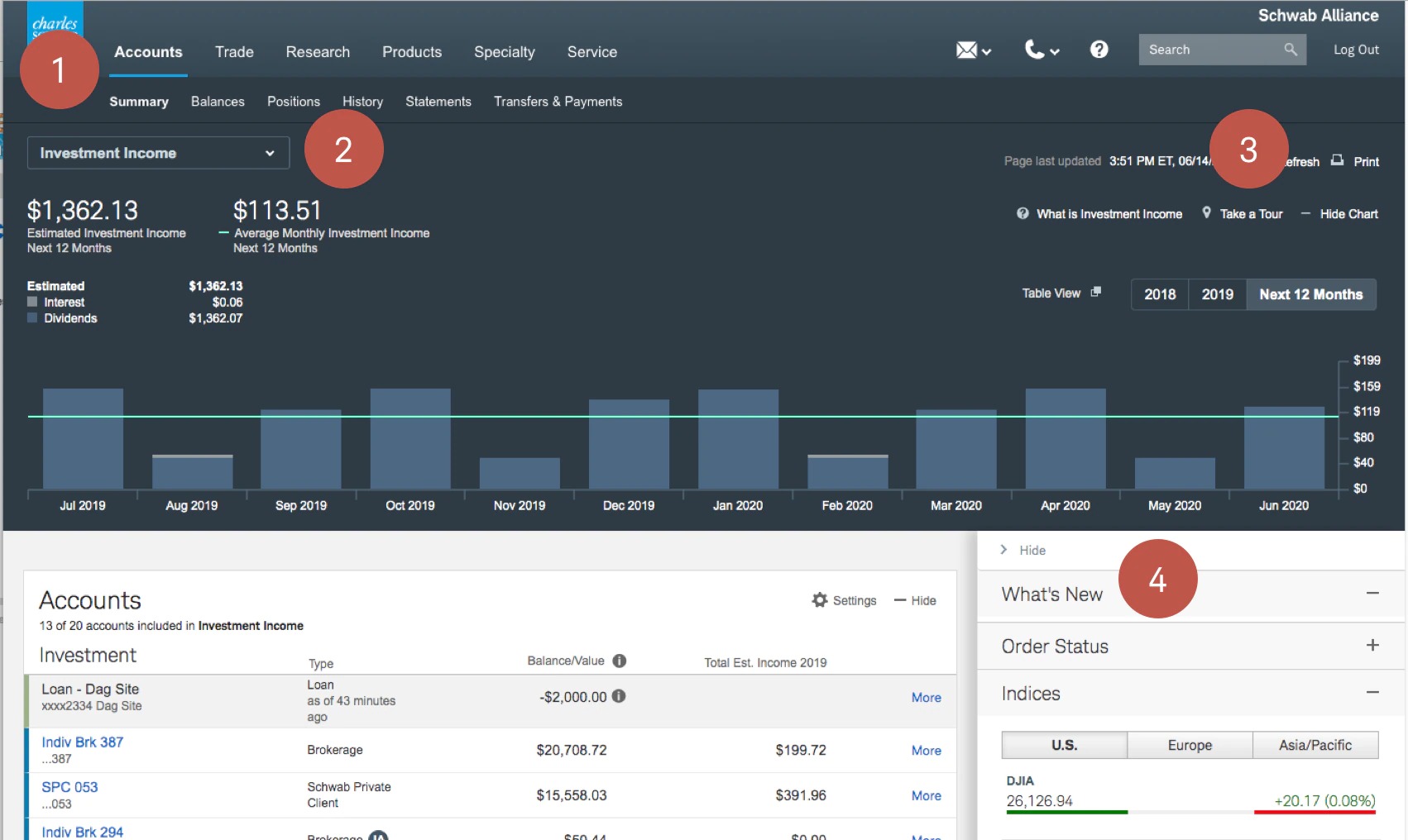

Finance
What Is Annual Savings Adjustment (Schwab)
Published: January 16, 2024
Learn about annual savings adjustment in finance with Schwab. Understand how this adjustment impacts your savings and financial goals.
(Many of the links in this article redirect to a specific reviewed product. Your purchase of these products through affiliate links helps to generate commission for LiveWell, at no extra cost. Learn more)
Table of Contents
- Introduction
- Definition of Annual Savings Adjustment
- Purpose of Annual Savings Adjustment
- How Annual Savings Adjustment Works
- Factors Considered in Annual Savings Adjustment
- Benefits of Annual Savings Adjustment
- Common Misconceptions about Annual Savings Adjustment
- Examples of Annual Savings Adjustment in Practice
- Conclusion
Introduction
Welcome to our comprehensive guide on annual savings adjustment! In the realm of personal finance, understanding the various mechanisms and strategies that can help us manage our money effectively is crucial. One such strategy is annual savings adjustment, a concept that plays a significant role in optimizing our savings and achieving our financial goals.
Saving money is a fundamental aspect of financial planning, but it’s not a static process. Our financial situations change over time, and what may have been an appropriate amount to save a year ago may not align with our current needs and circumstances. This is where annual savings adjustment comes into play – it allows us to reassess our savings goals and adapt them accordingly.
Annual savings adjustment involves periodically evaluating our income, expenses, and financial objectives to recalibrate our savings plan. By making necessary adjustments, we can ensure that our savings remain on track and in line with our evolving financial situation. However, it’s not just about randomly increasing or decreasing our savings; it requires careful analysis and consideration of various factors.
In this guide, we will take a closer look at the definition, purpose, and mechanics of annual savings adjustment. We will explore the factors that are taken into account when making adjustments, discuss the benefits it offers, dispel common misconceptions, and provide real-world examples of how annual savings adjustment can be applied.
Whether you are a seasoned investor or just starting on your financial journey, understanding how to effectively adjust your savings can make a significant difference in achieving your financial goals. So, let’s dive in and explore the world of annual savings adjustment!
Definition of Annual Savings Adjustment
Annual savings adjustment is a financial planning strategy that involves reassessing and modifying your savings goals and contributions on an annual basis. It is the process of reviewing your income, expenses, and financial objectives to ensure that your savings plan remains aligned with your current circumstances and goals. By making necessary adjustments, you can optimize your savings strategy and maintain financial stability.
To put it simply, annual savings adjustment is like fine-tuning your savings plan. Just as a car needs regular maintenance to run smoothly, your savings plan needs periodic adjustments to stay on track. This adjustment takes into account changes in income, expenses, and financial goals, providing you with a realistic and achievable savings target.
Why is it important to adjust your savings annually? The answer lies in the ever-changing nature of your financial situation. Your income may increase or decrease, expenses may fluctuate, and your financial goals may evolve. By adjusting your savings, you ensure that you are allocating an appropriate amount of money towards your goals and maintaining a healthy financial balance.
It’s essential to note that annual savings adjustment is not about randomly increasing or decreasing your savings amount. It involves an informed analysis of your personal finances and thoughtful consideration of various factors. By taking the time to assess your savings plan each year, you can make educated decisions that align with your current financial circumstances and long-term objectives.
In the next sections, we will explore the purpose of annual savings adjustment, how it works, and the factors that are taken into account when making adjustments. Understanding these aspects will give you a comprehensive understanding of how to effectively implement this strategy and reap the benefits it offers.
Purpose of Annual Savings Adjustment
The primary purpose of annual savings adjustment is to ensure that your savings strategy remains aligned with your current financial situation and long-term goals. By regularly assessing and modifying your savings plan, you can maximize the effectiveness of your savings efforts and stay on track towards achieving your financial objectives.
One of the main reasons for conducting an annual savings adjustment is the dynamic nature of your financial circumstances. Your income, expenses, and financial goals are not static; they can change over time. By adjusting your savings on an annual basis, you can adapt to these changes and make appropriate modifications to your savings goals.
Another purpose of annual savings adjustment is to maintain a realistic and attainable savings target. By reviewing your financial situation, you can evaluate if your current savings contributions are sufficient or need to be adjusted. This helps you avoid saving too little or too much, ensuring your savings align with your overall financial plan.
Additionally, annual savings adjustment allows you to prioritize your financial goals. Over time, you may have new goals that require additional savings, while others may decrease in priority. By conducting an annual assessment, you can reassess your goals and adjust your savings accordingly, ensuring you allocate your resources in the most effective way.
Furthermore, annual savings adjustment helps you adapt to unexpected financial events. Life is full of surprises, and there may be unforeseen expenses or changes in your income that impact your savings. By regularly reviewing your savings plan, you can proactively respond to these events, making necessary adjustments to keep your finances stable.
Lastly, annual savings adjustment promotes financial discipline and awareness. By examining your savings plan each year, you develop a deeper understanding of your financial habits, identify areas for improvement, and become more conscious of your spending and saving patterns. This increased awareness can lead to better financial decision-making and improved overall financial well-being.
In the following sections, we will delve into how annual savings adjustment works and the factors that are considered when making adjustments. By understanding these aspects, you will be equipped with the knowledge to implement effective annual savings adjustments and reap the benefits that come with it.
How Annual Savings Adjustment Works
Annual savings adjustment involves a systematic process of reviewing and modifying your savings plan on a yearly basis. It ensures that your savings remain in line with your current financial situation and goals. Let’s explore how this process works in practice.
1. Assess your financial situation: The first step in annual savings adjustment is to evaluate your overall financial situation. This includes reviewing your income, expenses, debts, and any significant changes in your financial circumstances. You need to have a clear understanding of your current financial status to make informed adjustments to your savings plan.
2. Review your financial goals: Next, take a close look at your long-term financial goals. Assess whether your goals have changed or if there are any new goals that need to be considered. It’s important to prioritize your goals and determine the level of savings required to achieve them. This step helps you align your savings plan with your objectives.
3. Analyze your savings contributions: Evaluate your current savings contributions in relation to your financial goals. Determine if you are on track to meet your objectives or if adjustments need to be made. Consider factors such as the time horizon for each goal, the required savings rate, and the level of risk tolerance.
4. Determine necessary adjustments: Based on your assessment, identify the adjustments that need to be made to your savings plan. This could involve increasing or decreasing your savings contributions. The goal is to ensure that your savings efforts remain realistic and attainable while accommodating any changes in your financial situation or goals.
5. Implement the adjustments: Once you have determined the necessary changes, it’s time to implement them. Update your budget and allocate the revised savings amounts to the appropriate financial goals. Be proactive in executing the adjustments to stay on track with your savings plan.
6. Monitor and track progress: After making the necessary adjustments, continue to monitor and track your savings progress throughout the year. Regularly review your savings plan and make minor course corrections if needed. This allows you to stay aware of any changes in your financial situation and make timely adjustments as required.
7. Repeat the process annually: Annual savings adjustment is not a one-time event. It’s an ongoing process that should be repeated on a yearly basis. Make it a habit to reassess your financial situation, review your goals, and adjust your savings plan accordingly. By doing so, you ensure that your savings strategy remains relevant and effective over time.
By following this systematic approach, you can effectively adjust your savings plan each year, ensuring that it remains aligned with your current financial circumstances and goals. The process allows you to proactively adapt to changes, maintain financial stability, and progress towards achieving your financial objectives.
Factors Considered in Annual Savings Adjustment
When conducting an annual savings adjustment, several factors need to be taken into account to ensure that your savings plan aligns with your current financial situation and goals. These factors play a crucial role in determining the adjustments that need to be made. Let’s explore some of the key considerations when adjusting your savings plan.
1. Income changes: Any changes in your income, such as salary increases, bonuses, or fluctuations in self-employment earnings, should be considered. If your income has increased, you may have the flexibility to increase your savings contributions. On the other hand, if your income has decreased, you may need to adjust your savings downward to maintain a balanced financial plan.
2. Expense fluctuations: Review any changes in your expenses over the past year. Take into account increases or decreases in living expenses, healthcare costs, debt payments, and other financial obligations. If your expenses have risen significantly, you may need to adjust your savings accordingly to accommodate these changes.
3. Financial goals: Assess whether your financial goals have changed or if new goals have emerged. Consider the timeframe and priority of each goal. If you have added new goals, you may need to increase your savings contributions. If a particular goal has become less important, you can allocate the savings from that goal to other priorities.
4. Risk tolerance: Take into consideration your risk tolerance when determining your savings adjustments. If you have a higher risk tolerance, you may choose to allocate a larger portion of your savings towards investments with potentially higher returns. Conversely, if you have a lower risk tolerance, you may opt for more conservative savings vehicles, such as a traditional savings account or certificates of deposit.
5. Emergency fund: Your emergency fund is an essential part of your financial security. Evaluate whether your current emergency fund is adequate to cover unexpected expenses. If it falls short, you may need to allocate additional savings towards building or replenishing your emergency fund.
6. Retirement savings: Assess your retirement savings contributions and the progress towards your retirement goals. Consider adjusting your savings if you need to accelerate your retirement savings or if your retirement goals have changed. It’s important to ensure that you are on track to achieve a comfortable retirement.
7. Market conditions: Monitor the performance of your investments and the prevailing market conditions. Adjust your savings strategies accordingly based on the performance and outlook of your investment portfolio. Stay informed about market trends and seek professional advice if necessary.
By considering these factors and conducting a comprehensive evaluation of your financial situation, goals, and risk tolerance, you can make informed decisions when adjusting your savings plan. Remember that the specific factors that apply to you may vary, so it’s crucial to tailor your savings adjustments based on your unique circumstances and objectives.
Benefits of Annual Savings Adjustment
Engaging in annual savings adjustment offers a range of benefits that can positively impact your financial well-being and help you achieve your long-term goals. Let’s explore some of the key advantages of regularly adjusting your savings plan.
1. Realistic savings targets: Conducting an annual savings adjustment allows you to set realistic and achievable savings targets. By reassessing your financial situation and goals, you can align your savings contributions with your current income, expenses, and financial aspirations. This ensures that you are neither saving too little nor overburdening yourself by saving too much.
2. Adaptability to changing circumstances: Life is full of surprises, and your financial situation can evolve over time. Annual savings adjustment enables you to adapt to these changes by modifying your savings goals and contributions. Whether it’s a change in income, unexpected expenses, or shifting financial priorities, adjusting your savings plan ensures that you stay on track despite these fluctuations.
3. Maximizing savings potential: Regularly reviewing and adjusting your savings plan allows you to maximize your savings potential. By consistently evaluating your goals, expenses, and income, you can identify opportunities to increase your savings contributions or allocate funds to higher-priority financial objectives. This optimization can accelerate your progress towards achieving your financial goals.
4. Financial discipline and awareness: Engaging in annual savings adjustment promotes financial discipline and enhances your overall financial awareness. It encourages you to review your income, expenses, and goals, fostering a deeper understanding of your financial habits and priorities. This increased awareness empowers you to make better-informed financial decisions and improve your overall financial well-being.
5. Long-term financial stability: Adjusting your savings plan on an annual basis is a proactive approach to maintain long-term financial stability. By regularly assessing and adapting your savings goals, you are better equipped to handle unexpected financial challenges and seize opportunities for growth. The consistency in your savings adjustments ensures that your financial plan remains robust and resilient to changes in the economic landscape.
6. Flexibility in achieving goals: As your financial goals evolve, annual savings adjustment provides you with the flexibility to allocate your resources effectively. Whether you have new goals that require additional savings or your priorities have shifted, adjusting your savings plan allows you to realign your efforts and ensure that your resources are directed towards your current objectives.
7. Peace of mind: Regularly adjusting your savings plan can provide you with a sense of peace and confidence. Knowing that your savings contributions are in line with your current financial situation and goals alleviates unnecessary stress and uncertainty. This peace of mind allows you to focus on other aspects of your life, knowing that you are on track towards achieving financial security.
By embracing the benefits of annual savings adjustment, you can optimize your savings strategy, adapt to changes, and proactively work towards your financial goals. Remember, regular evaluation and adjustment are key to ensuring that your savings plan remains relevant and effective as your financial journey unfolds.
Common Misconceptions about Annual Savings Adjustment
While annual savings adjustment is a powerful financial strategy, there are some common misconceptions that can hinder its effectiveness. Let’s address these misconceptions and provide clarity on the true nature of annual savings adjustment.
1. Myth: Annual savings adjustment is only for wealthy individuals.
Reality: Annual savings adjustment is beneficial for individuals of all income levels. It’s not just restricted to those with higher incomes. Adjusting your savings plan annually allows you to align your savings goals and contributions with your current financial situation, regardless of your income level.
2. Myth: I don’t need to adjust my savings if my income remains the same.
Reality: Even if your income remains steady, an annual savings adjustment is still necessary. Your expenses, financial goals, and market conditions can change, requiring you to make adjustments to your savings plan. Regular evaluation ensures that your savings efforts remain relevant and effective, regardless of changes in income.
3. Myth: Annual savings adjustment means I have to save more every year.
Reality: Annual savings adjustment is not always about saving more. It involves assessing your financial situation and goals to determine the appropriate savings contributions. In some cases, you may need to save more, while in others, you may be able to maintain your current savings level or even reduce it if your circumstances allow.
4. Myth: I can wait until later to start annual savings adjustment.
Reality: It’s never too early or too late to start annual savings adjustment. The earlier you begin, the better positioned you will be for long-term financial success. However, if you haven’t been adjusting your savings annually, it’s essential to start as soon as possible to ensure that your savings plan remains on track.
5. Myth: I can’t adjust my savings once I set my goals.
Reality: Financial goals are not set in stone, and they can evolve over time. Adjusting your savings plan allows you to adapt to changing circumstances and reprioritize goals. If your goals change or new priorities emerge, adjusting your savings ensures that your resources are allocated accordingly.
6. Myth: Annual savings adjustment is too complicated and time-consuming.
Reality: While assessing and adjusting your savings plan requires some thoughtful consideration, it doesn’t have to be complicated or time-consuming. By setting aside dedicated time annually to evaluate your finances and make necessary adjustments, you can streamline the process and ensure that your savings plan remains optimized.
7. Myth: I can’t adjust my savings if I have debt.
Reality: Adjusting your savings plan does not mean neglecting your debt obligations. It’s important to strike a balance between saving for the future and managing your debt. While it may be necessary to allocate more towards debt payments initially, as you make progress in paying off your debt, you can gradually increase your savings contributions.
By dispelling these misconceptions, we can better understand the true value and purpose of annual savings adjustment. It’s a flexible and adaptable strategy that can benefit individuals at any income level, allowing them to proactively manage their financial well-being and work towards their long-term financial goals.
Examples of Annual Savings Adjustment in Practice
To provide a better understanding of how annual savings adjustment works in practice, let’s explore a couple of examples showcasing how individuals can make adjustments to their savings plan based on their changing financial circumstances and goals.
Example 1: Julia’s Income Increase
Julia received a promotion at work, which came with a significant increase in her salary. She decides to conduct an annual savings adjustment to ensure that she is making the most out of her newfound income. After assessing her financial situation and goals, she realizes that she can increase her savings contributions to accelerate her progress towards retirement and save for a down payment on a house.
Julia increases her retirement savings contributions by 2% of her new salary, which aligns with her long-term retirement goals. She also allocates an additional amount towards her down payment savings fund, taking advantage of her higher income. By making these adjustments, Julia is taking full advantage of her increased earnings while staying on track with her financial objectives.
Example 2: Mark’s Changing Expenses
Mark experiences a significant increase in his living expenses due to the rising costs of housing, utilities, and healthcare. He realizes that his current savings contributions may not be sufficient to cover these increased expenses and maintain progress towards his financial goals. Through an annual savings adjustment, Mark identifies areas where he can make adjustments to his savings plan.
Mark reevaluates his budget and identifies opportunities to minimize discretionary spending. He decides to allocate the savings from these areas towards his emergency fund and short-term savings goals. By cutting back on non-essential expenses, Mark is able to make the necessary adjustments to his savings plan, ensuring that he has sufficient funds to cover his increased living costs while still prioritizing his financial goals.
These examples illustrate how individuals can benefit from annual savings adjustment by adapting their savings plan to their changing financial circumstances and goals. It’s important to note that everyone’s situation is unique, and the specific adjustments needed will vary. Regularly assessing and adjusting your savings plan ensures that it remains customized to your individual needs and objectives.
Remember, annual savings adjustment is a proactive strategy that empowers you to optimize your savings efforts, maintain financial stability, and work towards achieving your long-term financial goals. By consistently evaluating your financial situation, goals, and other variables, you can make informed decisions to adapt your savings plan and position yourself for financial success.
Conclusion
In conclusion, annual savings adjustment is a crucial financial planning strategy that allows individuals to adapt their savings plan to their changing financial circumstances and goals. By conducting a yearly assessment and modifying savings contributions, individuals can ensure that their savings efforts remain aligned and optimized.
The purpose of annual savings adjustment is to set realistic savings targets, adapt to changing circumstances, maximize savings potential, promote financial discipline and awareness, and maintain long-term financial stability. By considering factors such as income changes, expense fluctuations, financial goals, and risk tolerance, individuals can make informed decisions when adjusting their savings plan.
It’s important to dispel common misconceptions about annual savings adjustment, such as it being applicable only to the wealthy or complex and time-consuming. The truth is that annual savings adjustment is beneficial for individuals at all income levels and can be streamlined to fit within one’s lifestyle.
To implement annual savings adjustment effectively, individuals should reassess their financial situation, review their goals, analyze savings contributions, determine necessary adjustments, and monitor progress throughout the year. By following this systematic approach, individuals can ensure that their savings plan remains relevant, adaptable, and aligned with their objectives.
Examples further illustrate how individuals can adjust their savings plan based on changing income, expenses, and goals. These examples reinforce the idea that annual savings adjustment is a flexible and personalized strategy that can be tailored to fit individual needs and circumstances.
Ultimately, embracing annual savings adjustment empowers individuals to take control of their financial future. It allows for flexibility, adaptability, and optimization of savings efforts, enabling individuals to progress towards their long-term financial goals with confidence and peace of mind.
So, whether you are just starting on your financial journey or are a seasoned investor, don’t overlook the importance of annual savings adjustment. By implementing this strategy, you are taking a proactive step towards achieving financial stability, growth, and greater control over your financial well-being.














